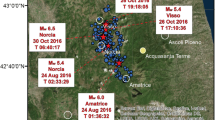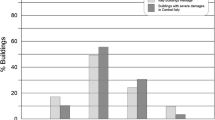Abstract
Kyrgyzstan is an earthquake-prone country at the border of the Pamir Thrust, north of the active shortening structure of the Pamir Mountains and the intra-continental mountain belt of the Tian Shan further north. The region has had several M7 + damaging earthquakes, which have killed thousands of people. In the West, the country is cut through by the 700-km-long NW–SE Talas-Fergana active strike-slip fault system, where no major earthquakes have been observed in the last 250 years even though paleoseismic studies show the potential to produce M7.0 + events. This study is the second part of a project to estimate the potential damage and losses on residential buildings as well as critical infrastructures in the case of a large earthquake in the two mining towns of Kadamjay and Aidarken in the SW of Kyrgyzstan. Microtremors were recorded on 82 sites and analyzed with the Horizontal-to-Vertical Spectral Ratio (HVSR) method. For each site, we estimate the average frequency of the clearest peak and its amplitude in the HVSR spectra to produce microzonation maps, in terms of response frequency. We further used these data for the calculation of ground shaking using a set of six seismic scenarios based on the known faults around the two towns. This approach has proved to be efficient in a country where the resources and available data are limited and when the time of investigation is short. The Kadamjay and Aidarken cities have been divided into different zones with specific predominant resonance frequency ranges, which information is useful for risk analysis, mitigation and buildings retrofit. In Kadamjay, three regions dominate which are related to the history of alluvial deposition in a series of terraces. The more elevated terrace could be the place of seismic site amplification. Aidarkan is much more homogenous in terms of thickness and type of alluvial deposits.











Similar content being viewed by others
References
Abdrakhmatov K, Aldazhanov S, Hager B, Hamburger M et al (1996) Relatively recent construction of the Tien Shan inferred from GPS measurements of present-day crustal deformation rates. Nature 384:450–453
Abdrakhmatov K, Havenith H-B, Delvaux D, Jongmans D, Trefois P (2003) Probabilistic PGA and Arias intensity maps of Kyrgyzstan (Central Asia). J Seismolog 7:203–220
Abdrakhmatov K (2009) Establishment of the Central Asia Seismic Risk Initiative (CASRI). Technical Report on the Work Performed from: 02.01.2006 to 04.30.2009, ISTC Project No. KR 1176, Institute of Seismology, National Academia of Sciences, Kyrgyz Republic.
Allen MB, Windley BF, Chi Z (1992) Palaeozoic collisional tectonics and magmatism of the Chinese Tien Shan, Central Asia. Tectonophysics 220:89–115
Bard P-Y, Catello A, Aguacil G et al (2008) Guidelines for the implementation of the H/V spectral ratio technique on ambient vibrations measurements, processing and interpretation. Bull Earthq Eng 6(4):1–2
Bindi D, Abdrakhmatov K, Parolai S, Mucciarelli M, Gruenthal G, Ischuk A, Mikhailova N, Zschau J (2012) Seismic hazard assessment in Central Asia: outcomes from a site approach. Soil Dyn Earthq Eng 37:84–91
Coddington J, Burgette RJ (2018) Structural evolution of basins in the Tien Shan: the example of Jumgal basin, Kyrgyzstan. Presented at American Geophysical Union Fall Meeting, Washington DC, USA 2018:T51F-0237
DeMets C, Gordon RG, Argus DF (2010) Geologically current plate motions. Geophys J Int 181(1):1–80
EN 1998–1 (2004). Eurocode 8: Design of structures for earthquake resistance—Part 1: General rules, seismic actions and rules for buildings [Authority: The European Union Per Regulation 305/2011, Directive 98/34/EC, Directive 2004/18/EC. https://regbar.com/wp-content/uploads/2019/09/Eurocode-8-1-Earthquakes-general.pdf.
Gruenthal G (1998) European Macroseismic Scale; Conseil de l'Europe: Luxembourg, 1998.
Havenith H-B, Strom A, Torgoev I, Torgoev A, Lamair L, IschukA AK (2015) Tien Shan geohazards database: earthquakes and landslides. Geomorphology 249:16–31
Ischuk A, Bjerrum LW, Kamchybekov M, Abdrakhmatov K, Lindholm C (2018) Probabilistic seismic hazard assessment for the area of Kyrgyzstan, Tajikistan, and Eastern Uzbekistan. Central Asia Bull Seis Soc Am 108(1):130–144. https://doi.org/10.1785/0120160330
Kamchybekov MP, Egemberdieva KA, Charimov TA, Kamchybekov YP (2013) Macroseismic survey of the Kansk earthquake. Bulletin of the Institute of Seismology of the National Academy of Sciences of the Kyrgyz Republic, No 1:40–49
Konno K, Ohmachi T (2000) Ground-motion characteristics estimated from spectral ratio between horizontal and vertical components of microtremor. Bull Seismol Soc Am 88(1):228–241
Lunedei E, Malischewsky PA (2015) Review and Some New Issues on the Theory of the H/V Technique for Ambient Vibrations. In: Ansal A. (eds) Perspectives on European Earthquake Engineering and Seismology. Geotechnical, Geological and Earthquake Engineering, 39. Springer, Cham. https://doi.org/10.1007/978-3-319-16964-4_15
Mohadjer S, Ehlers TA, Bendick R, Stübner K, Strube T (2016) A Quaternary fault database for central Asia. Nat Hazards Earth Syst Sci 16:529–542. https://doi.org/10.5194/nhess-16-529-2016
Molnar P, Tapponier P (1975) Cenozoic Tectonics of Asia: effects of a continental collision. Science 189:419–426
Molnar S, Cassidy JF, Castellaro S et al (2018) Application of Microtremor Horizontal-to-Vertical Spectral Ratio (MHVSR) analysis for site characterization: state of the art. Surv Geophys 39:613–631. https://doi.org/10.1007/s10712-018-9464-4
Rosset P, Tolis S, Wyss M (2020) The use of QLARM to estimate seismic risk in Kirghizstan at the regional and city scales. Acta Geophys 68:979–991. https://doi.org/10.1007/s11600-020-00449-6
Rosset P, Tolis S, Speiser M, Wyss M (2021) QLARM, un outil au service de la gestion du risque sismique et des crises; Étude de cas au Kirghizstan. In: Leone F, Vinet F (eds) Presse Universitaire de Montpellier, editors: , Géorisque 9:115–126 (In French)
Thompson SC, Weldon RJ, Rubin CM, Abdrakhmatov K, Molnar P, Berger GW (2002) Late Quaternary slip rates across the central Tien Shan, Kyrgyzstan. Central Asia J Geophys Res 107(B9):2203. https://doi.org/10.1029/2001JB000596
Torgoev I, Aleshin YG (2009) Geoecology and wastes of the mining complex of Kyrgyzstan. Bishkek: ILIM, 2009 (in Russian).
Trendafiloski G, Wyss M, Rosset P, Marmureanu G (2009) Constructing city models to estimate losses due to earthquakes worldwide: application to Bucharest Romania. Earthq Spectra 25(3):665–685
Trendafiloski G; Wyss M and Rosset P (2011). Loss estimation module in the second generation software QLARM. In: Spence R, So E, Scawthorn C (eds) Human casualties in earthquakes: progress in modeling and mitigation. Springer, Cham, pp 381–391.
Wathelet M, Chatelain J-L, Cornou C, Di Giulio G, Guillier B, Ohrnberger M, Savvaidis A (2020) Geopsy: a user-friendly open-source tool set for ambient vibration processing. Seismol Res Lett 91(3):1878–1889
Wyss M, Elashvili M, Jorjiashvili N, Javakhishvili Z (2011) Uncertainties in teleseismic earthquake locations: implications for real-time loss estimates. Bull Seismol Soc Am 101:1152–1161
Wyss M, Speiser M, Tolis S (2022) Earthquake fatalities and potency. Nat Hazards (in Press).
Zubovich AV, Wang X, Scherba YG, Schelochkov GG et al (2010). GPS velocity field for the Tien Shan and surrounding regions. Tectonics 29(6), TC6014.
Acknowledgements
This work was carried out thanks to the financial support of Médecins Sans Frontières in Switzerland (MSF) and to the local MSF logistic team located in Bishkek and Kadamjay. The project was executed under the auspice of the Kyrgyz Minister of Emergency. We thank Dr. Stavros Tolis for the coordination of the building survey and related aspects in both towns. The Foundation ICES team thanks the Earth Science Dept. of the University of Geneva, Switzerland, for the loan of the seismic instrument Tromino used for the HVSR analysis. This manuscript has benefited from the comments of Prof. H.B. Havenith and an anonymous reviewer.
Funding
This work was carried out thanks to the financial support of Médecins Sans Frontières in Switzerland (MSF).
Author information
Authors and Affiliations
Contributions
MW and PR contributed to conceptualization, PR contributed to methodology, formal analysis and validation; PR contributed to field investigation; PR contributed to writing—original draft preparation; all authors have read and agreed to the published version of the manuscript.
Corresponding author
Ethics declarations
Conflict of interest
The authors have no conflicts of interest to declare that are relevant to the content of this article. For this type of study, formal consent is not required. On behalf of all authors, the corresponding author states that there is no conflict of interest.
Additional information
Edited by Dr. Salvatore Gambino (ASSOCIATE EDITOR) / Prof. Savka Dineva (CO-EDITOR-IN-CHIEF).
Supplementary Information
Below is the link to the electronic supplementary material.
Rights and permissions
Springer Nature or its licensor (e.g. a society or other partner) holds exclusive rights to this article under a publishing agreement with the author(s) or other rightsholder(s); author self-archiving of the accepted manuscript version of this article is solely governed by the terms of such publishing agreement and applicable law.
About this article
Cite this article
Philippe, R., Wyss, M. Seismic microzonation study for two mining cities in the SW of Kyrgyzstan. Acta Geophys. 71, 293–307 (2023). https://doi.org/10.1007/s11600-022-00957-7
Received:
Accepted:
Published:
Issue Date:
DOI: https://doi.org/10.1007/s11600-022-00957-7




